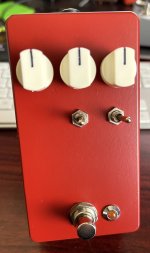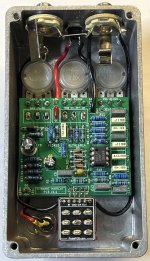MichaelW
Well-known member
- Build Rating
- 5.00 star(s)
A few months back @MattG was kind enough to send me a couple of his custom boards to build out.
With my "Great Build Output Slowdown of 2023" it's taken me a while to get to it.
But I ventured into the frozen tundra of my garage and managed to get a little bench time in and built out this very cool pedal.
Matt and I both have an admiration for Dave Barber's pedals, the OG booteek overdrive designer.
The "Gain Changer" has it's roots in the LTD/LTD SR series and is kind of a combination of both of these pedals.
In fact, the retail Gain Changer was the last retail overdrive pedal I bought shortly before finding this forum and starting on my DIY journey.
I wound up selling it because I adopted a hard core "DIY or Die" attitude
Like most of Barber overdrives, it's a bit of a Swiss Army knife overdrive. With the gain structure toggle and the EQ toggle it can do the "transparent Timmy" thing but it can also do the TS808 thing as well. There are a lot of really great tones in this pedal and @MattG did an awesome job with his trace and board for this.
It really sounds exactly how I remember my retail GC sounding.
Very straightforward build with modest amount of components, went very smooth and fired right up.
It sounds as good with single coils as humbuckers and like most of Barber pedals it doesn't have a ton of low end. But it definitely stands out in a mix with the way it sits in a particular frequency range.
Thanks @MattG it was a super fun build and it sounds great!
Working through my last few raw enclosures with rattle can paint. This one, I primed and then painted with a brick red. Still seems like it needs multiple coats to get all the little enclosure imperfections covered.


With my "Great Build Output Slowdown of 2023" it's taken me a while to get to it.
But I ventured into the frozen tundra of my garage and managed to get a little bench time in and built out this very cool pedal.
Matt and I both have an admiration for Dave Barber's pedals, the OG booteek overdrive designer.
The "Gain Changer" has it's roots in the LTD/LTD SR series and is kind of a combination of both of these pedals.
In fact, the retail Gain Changer was the last retail overdrive pedal I bought shortly before finding this forum and starting on my DIY journey.
I wound up selling it because I adopted a hard core "DIY or Die" attitude
Like most of Barber overdrives, it's a bit of a Swiss Army knife overdrive. With the gain structure toggle and the EQ toggle it can do the "transparent Timmy" thing but it can also do the TS808 thing as well. There are a lot of really great tones in this pedal and @MattG did an awesome job with his trace and board for this.
It really sounds exactly how I remember my retail GC sounding.
Very straightforward build with modest amount of components, went very smooth and fired right up.
It sounds as good with single coils as humbuckers and like most of Barber pedals it doesn't have a ton of low end. But it definitely stands out in a mix with the way it sits in a particular frequency range.
Thanks @MattG it was a super fun build and it sounds great!
Working through my last few raw enclosures with rattle can paint. This one, I primed and then painted with a brick red. Still seems like it needs multiple coats to get all the little enclosure imperfections covered.



